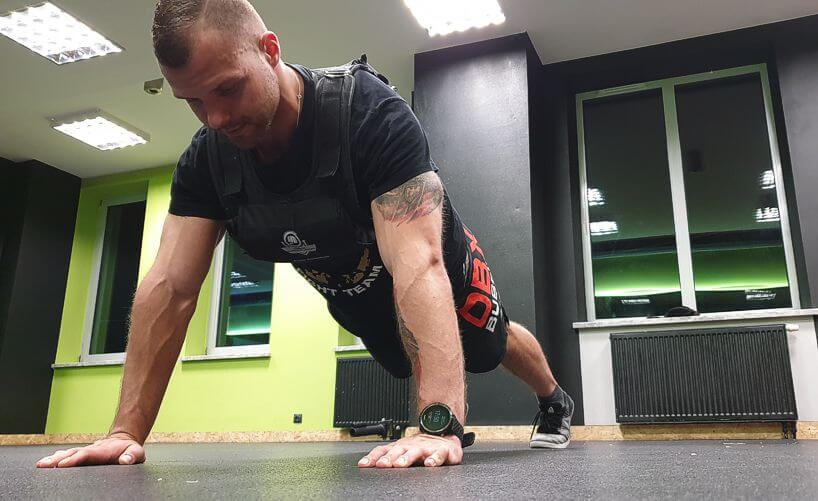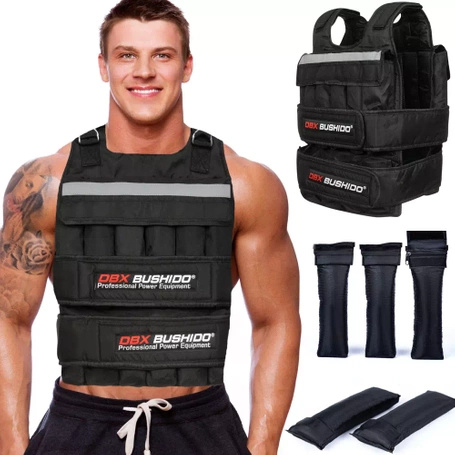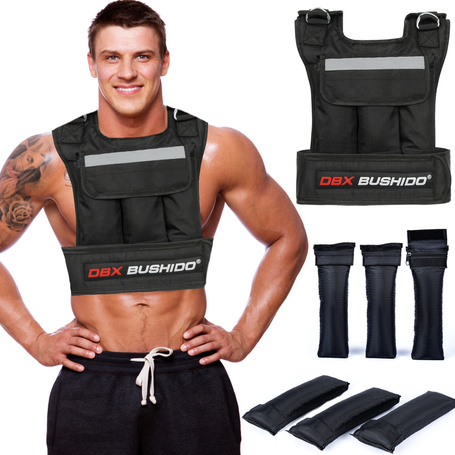Training vest in sports - How to use a weight vest in training?

How a weight vest can be used in training?
The weight vest can be used both by professional athletes of various sports and during recreational training. Its function is to put additional load on the muscles during physical activity which results in a significant acceleration of training effects.
Table of Contents entry:
- Weighted vest. What is?
- How the weight vest works?
- Vest in weight training.
- Vest in combat sports.
- Vest in crossfit training.
- Vest in long-distance running.
✅WHAT IS A WEIGHT VEST?
Physical activity is an increasingly popular leisure activity of choice. With the increase in popularity of sports, many, methods and training devices are being developed to diversify training.
Many of them are moved directly from the sports hall to a commercial gym so that recreational trainees can check out and feel how professional athletes train as they prepare for competition. One device that has been gaining popularity recently is the weight vest, which, interestingly enough, was not implemented from professional sports (as is most often the case) to recreation, but from the military.
Weighted vests began to be used in the army to mimic the load a soldier must carry during a combat mission. The entire combat load could prove too heavy for a novice soldier, so a variable vest load system was invented, where one could easily add or subtract loads from specially designed vest pockets. Soldiers performed long-distance runs in this instrumentation, as well as overcame obstacle courses to prepare for the hardships of battle and push the limits of their own endurance.
So if we would like to buy a training vest, when to use it?
Which weight vest to choose?
And most importantly how to train in it in terms of the sport we practice?
✅ HOW THE WEIGHT VEST WORKS?
The training vest is made of durable and thick material. It is best to wear it over a T-shirt so that it does not cause abrasions on the skin when performing dynamic training. The general purpose of the vest is to add extra weight to your body weight so that during training you force your body to work harder, which will ultimately translate into better fitness and muscular endurance. This is not the only use of the vest.
Below we will discuss the most popular sports in which vests are used. I will also show you some exercises using it.
✅ USE OF WEIGHT VEST IN STRENGTH TRAINING.
The weight vest can be used both by amateurs for typical recreational exercises at the gym and by professional athletes. It is worth noting at the outset that the use of the vest is safe if we keep in mind a few things. It is not advisable to use a weight vest in beginners who are very overweight, since fat tissue is already enough of a burden on the knees and other joints by itself.
In these people, the vest should be used judiciously, because by adding external load, we can only lead to injury. For beginners without excessive weight, the vest will find its use as much as possible, as long as you do not exaggerate the load. It is best to start with a load of 1 to 6 kg gradually increasing with the degree of sophistication of the trainee. Of course, these rules are not rigid and it all depends on the form of your mentee or yourself.
Due to its handy shape and size, the vest can be used, for example, for training at home or on a trip, where we do not have the opportunity to use professional training equipment.
All multi-joint exercises such as sentences or squats can be made more difficult by adding a vest load in a very safe way. The vest sits on our body and thus close to our center of gravity. This makes the exercise easier for a person starting out in resistance training, as he or she does not have to control the load away from the center of gravity held in the hands in the form of, for example, a barbell or kettlebell.

For advanced individuals who train recreationally or for people who are concerned about developing muscle mass, the vest will be great for increasing the difficulty of exercises, especially in exercises where it is relatively difficult to progress the weight. We are, of course, talking about pull-ups on a bar and push-ups, where we do not have the opportunity to use an additional load such as a barbell.
A weight vest is a great and, most importantly, safe and comfortable way to make these exercises more difficult. It will also come in handy as a tool to crank up your metabolism and burn fat. To do this, just use it when performing a tabata or interval type workout with your own body weight and added a few pounds in the form of a vest.
Examples of exercises in which we can use the vest. Trunk and squat.

✅ COMBAT SPORTS TRAINING VEST.
The vest is often used in strength and endurance sports, that is, among other combat sports. Athletes value it primarily for the ability to add additional weight, without restraining movement, as is the case with the use of various types of irons. It will be great for strength movements that improve motor skills such as pull-ups, push-ups with a jump, box jumps. By putting the vest on yourself during training, you are left with the impression of performing a workout with your own body weight enriched by only a few kilograms.
It is worth noting that the vest is a relatively small and inexpensive piece of equipment that gives you the opportunity to carry out a comprehensive strength training despite the lack of barbells, kettlebells, etc. The vest is also suitable for strength and endurance training such as circuit training or strength and conditioning training.
Push-ups and pull-ups are two exercises valued by combat sports athletes that strengthen the back and chest cardio. The vest works perfectly here.

✅ WEIGHT VEST IN CROSSFIT TRAINING.
The weight vest is highly valued in another strength and endurance sport, crossfit training.
Athletes practicing this sport use vests to fatigue the body more during individual WODs. By using the vest during preparation, we will make sure that when facing a similar challenge during a competition, we will be much better prepared for it. By turning out a given time with a load vest on, we are sure to improve it dramatically if we start at the competition without the additional load.
The question then arises whether there is a compulsion to use a vest, instead of simply trying to crank out the best time possible?
Adding a vest will definitely put more stress on the muscles and lead to faster acidification. This teaches our body to work harder and forces the body to learn to more quickly dispose of lactic acid from working muscles, excess of which manifests itself as unpleasant muscle burning. Very often, it is the failure of muscle enzymes that dispose of lactic acid to work fast enough that is the reason for poorer results.
✅ LONG-DISTANCE RUNNING TRAINING VEST.
Runners have also found uses for the weight vest. In long-distance running, it is used to strengthen the ankle joint and muscles. Running is, technically speaking, jumping from leg to leg. The heavier we are, the more mass we have to move both forward and upward.
Running with the vest, we strengthen the lower limbs, which translates into faster overcoming of uphill runs. Due to the high angle of the ground, running uphill is a strictly strength activity that requires stronger muscles. The runs, on the other hand, are a seemingly faster activity, but definitely more dangerous in terms of injury. When running down, we must brake our body weight using eccentric and isometric forces. If we are too weak for the uphill and downhill mountain runs we have to take during the competition, our attempt may end up with a knee, ankle, or lumbar spine injury. The vest helps strengthen just this type of strength, and in a dynamic way, which is what is needed in the sport of running. It is worth considering the vest as a bridge between the strength, built in the gym, and endurance developed during running training. The weight vest will help us convert the strength gained in the gym into a faster and safer running stride.
Runners also use the vest when they don't have as much elevation in the area as mountain hills. When training in a flat region, you can find even a small mountain, and make running up it more difficult with a weighted vest, without having to go into mountainous terrain.
Lateral strike is an exercise that strengthens the lower limbs and protects them from injury during running.

Author of the article:
Artur Jobda
Personal trainer and motor preparation coach.
https://www.youtube.com/c/ArturJobdaTrener0808
See also:
COPYRIGHT
Book: modern functional training - Boyle Michael
Choi HJ, Kang HJ. Study of gait using weighted vests on balance with paraplegic patients. J Exerc Rehabil. 2017;13(3):348-352. Published 2017 Jun 30. doi:10.12965/jer.1734984.492
Janet M. Shaw, Christine M. Snow, Weighted Vest Exercise Improves Indices of Fall Risk in Older Women, The Journals of Gerontology: Series A, Volume 53A, Issue 1, January 1998, Pages M53-M58,
Rantalainen, Timo; Ruotsalainen, Ilona; Virmavirta, Mikko; Effect of Weighted Vest Suit Worn During Daily Activities on Running Speed, Jumping Power, and Agility in Young Men; Journal of Strength and Conditioning Research: November 2012- Volume 26- Issue 11- p3030-3035
Hakestad KA, Torstveit MK, Nordsletten L, Risberg MA. Effect of exercises with weight vests and a patient education program for women with osteopenia and a healed wrist fracture: a randomized, controlled trial of the OsteoACTIVE program. BMC Musculoskeletal Disord. 2015;16:352. Published 2015 Nov 14. doi:10.1186/s12891-015-0811-z
Rey, Ezequiel; Padrón-Cabo, Alexis; Fernández-Penedo, Diego; Effects of Sprint Training With and Without Weighted Vest on Speed and Repeated Sprint Ability in Male Soccer Players; The Journal of Strength & Conditioning Research: October 2017- Volume 31- Issue 10- p 2659- 2666





